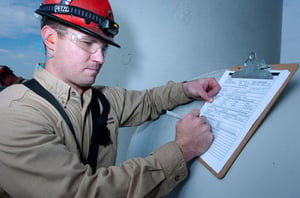Rescue Plans…What is required?

We had a very interesting inquiry regarding OSHA’s requirements for rescue plans and wanted to share it with you.
Reader’s Question: Does OSHA 1910.146 (k)(1)(v) state that a plan must be developed by a rescue service before an entry can be made? Can entries be conducted with the understanding that a rescue service has the competence to rescue someone without seeing the space prior?
Section (k)(1)(v) of the regulation states that the employer shall…“Provide the rescue team or service selected with access to all permit spaces from which rescue may be necessary so that the rescue service can develop appropriate rescue plans and practice rescue operations.” [Emphasis added]
Although the regulations do not specifically state that a “plan must be developed by a rescue service before an entry can be made,” the regulation assumes that a properly selected (and evaluated) rescue team or service will develop appropriate rescue plans, and requires that rescuers be given access as necessary to develop those plans. OSHA makes it very clear, however, in Non-Mandatory Appendix F, the Preamble to the Final Rule, Summary and Explanation of the Final Rule, and its Compliance Directive on Permit-Required Confined Space, that it interprets the regulation to require rescue plans. [See links below.]
How specific a “rescue plan” must be in order to meet OSHA requirements can be determined by answering this question…“How detailed must the rescue plan be to enable me to safely perform a timely rescue from the permit-required confined space being entered?” Generally speaking, the simpler and more generic the space and the entry, the simpler and less detailed the plan must be. The more complex the space and the hazards, the more specific and detailed the plan must be. And, the more likely the rescue service should see the space and/or a representative space in advance.
As such, the degree and content of the rescue plan should be determined by the rescue service – and it must be provided access to do so. Ultimately, however, it is the employer’s responsibility to perform an adequate evaluation of the prospective rescue service. The viability of the rescue plan should be demonstrated; therefore, proving that the rescue service is staffed, equipped, available, and proficient in performing timely rescue from that particular space (or representative space). The employer must be confident that the rescue service can “Talk the talk, and walk the walk.”
When evaluating the capabilities of a rescue service, Non-Mandatory Appendix F provides guidelines for doing so and specifically references “rescue plans” for the types of spaces involved. It is also important for employers to note that while it is “not mandatory” that the evaluation is performed in exactly the same way; you still have to reach the same result. In other words, it is a non-mandatory means of meeting the mandatory requirements.
Section B (1) of Appendix F asks…
Does the rescue service have a plan for each of the kinds of permit space rescue operations at the facility?
Is the plan adequate for all types of rescue operations that may be needed at the facility?
Note: Teams may practice in representative spaces, or in spaces that are ‘worst-case’ or most restrictive with respect to internal configuration, elevation, and portal size.
Appendix F also offers recommendations for determining whether a space is “truly” representative of an actual space. [See link below.]
You can also refer to Roco’s Confined Space Types Chart (click here to download) which illustrates various confined space types for rescue practice and planning purposes.
In summary, prior to permit required entry operations, the employer must afford the selected rescue service access to the permit spaces they may respond to for the purposes of rescue planning. The degree and content of the rescue plan should be determined by the rescue service. The rescue service must be prepared and proficient in rescue from the “same type(s) of confined spaces” in terms of configuration, access, and hazards.
IMPORTANT: The information in Roco Rescue Online is provided as a complimentary service for emergency response personnel. It is a general information resource and is not intended as legal advice. Because standards and regulations relating to this topic are typically performance based, and compliance with those standards and regulation is often dependent on the specific circumstances and conditions at hand, it is always important to carefully review all relevant standards and regulations, and to follow the proper protocols specific to your company or agency.
ONLINE REFERENCES:
OSHA 1910.146 Appendix F.
OSHA CPL 02-00-100, 5/5/1995, Application of the Permit-Required Confined Spaces (PRCS) Standards, 29 CFR 1910.146 Appendix D, V. Rescue, D. Combinations: 1. a.
OSHA 1910.146 Permit-Required Confined Spaces, Section: 2, II. Summary and Explanation of the Final Rule




